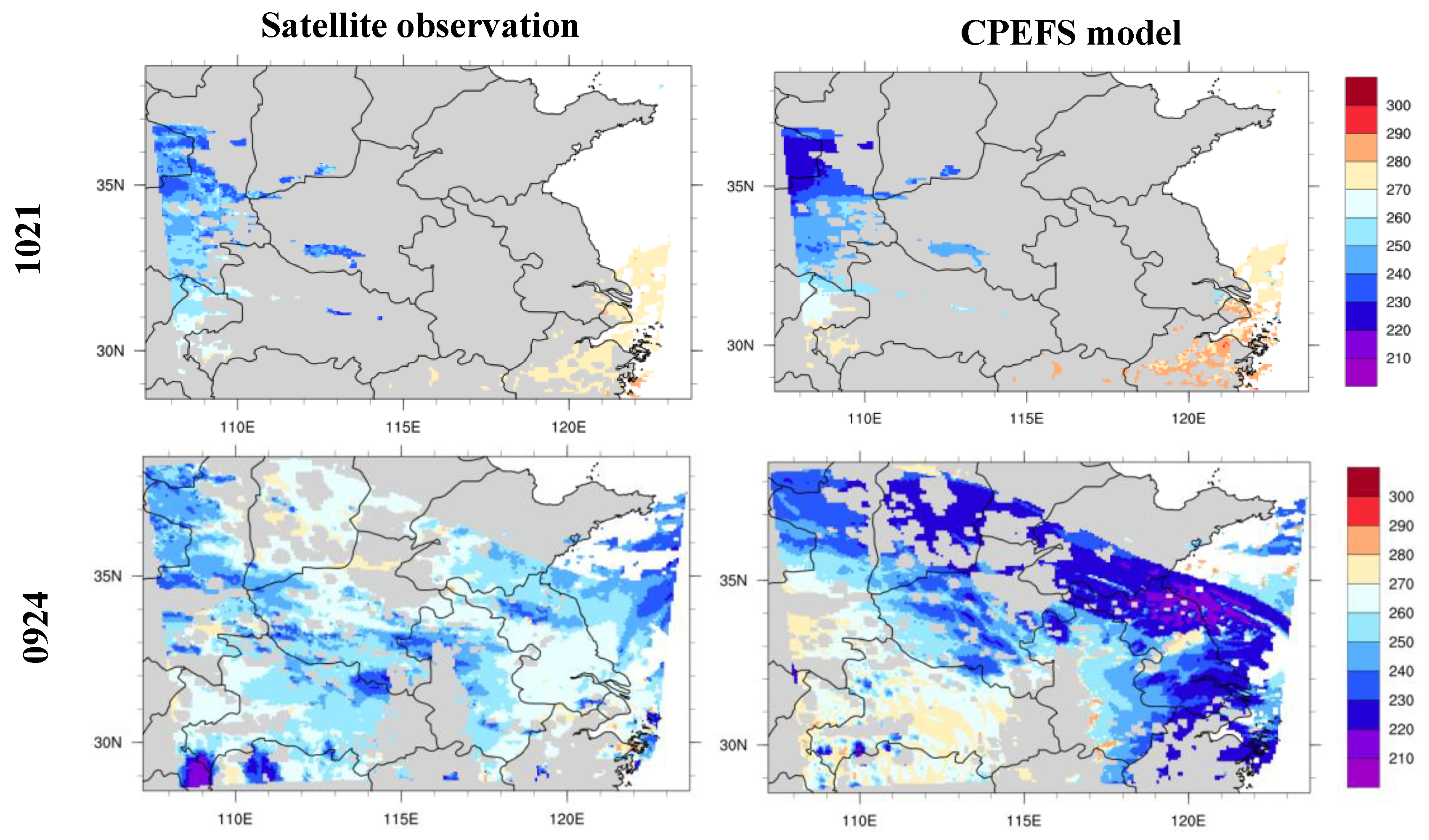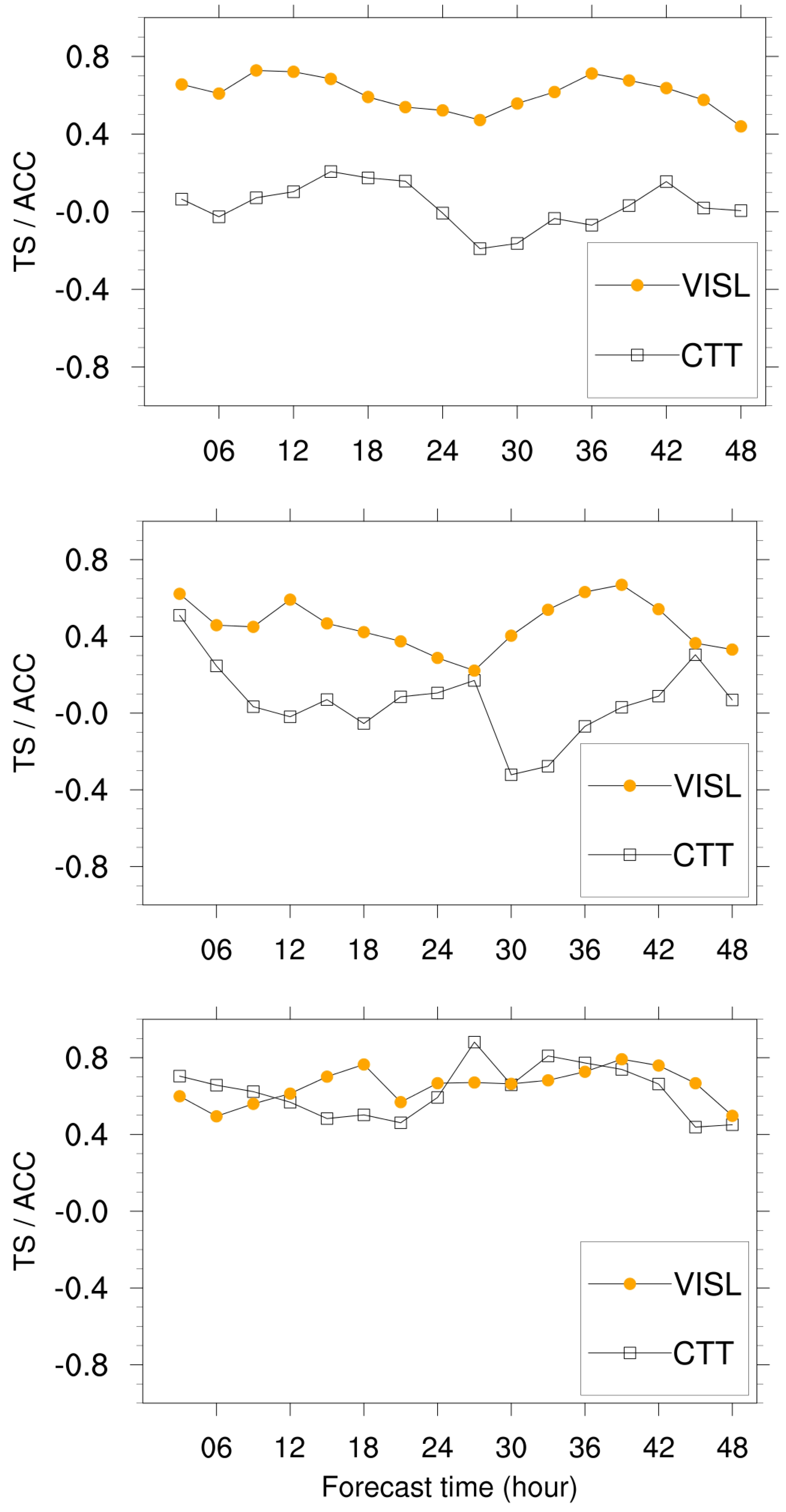Evaluation of the Forecasting Performance of Supercooled Clouds for the Weather Modification Model of the Cloud and Precipitation Explicit Forecasting System
Abstract
:1. Introduction
2. Materials and Methods
2.1. Verification Methods for the Weather Modification Model of CPEFS
2.2. Processing of the Himawari-8 Geostationary Satellite Cloud Products
2.3. Application of Integrated Precipitation Data from Automatic Meteorological Stations, Satellites, and Radars
3. Results
3.1. Variability in the Forecasting Performance of Supercooled Clouds for Cases
3.2. Correlation between the Forecasting Performance of Supercooled Clouds and Cloud Top Temperature Distribution
4. Conclusions and Discussions
- (1)
- On average, the forecasting performance of supercooled clouds by the weather modification model was relatively good, with a TS of 0.58. The results from the 12 UTC initialization were slightly better than those from the 00 UTC initialization. The spatial Anomaly Correlation Coefficient of cloud top temperature between forecasts and observations was 0.23, and the TS for 3 h precipitation exceeding 0.1 mm was 0.87.
- (2)
- The forecasting performance of supercooled clouds exhibited individual case differences. For example, in the case of 0904 initialized at 00 UTC, the highest TS reached 0.67, while in the case of 0921 initialized at 12 UTC, the lowest TS was only 0.46. False Alarm Rates ranged from 0.29 to 0.50, with a higher TS associated with lower False Alarm Rates. The Missed Detection Rates were as low as 0.03 to 0.13. Overall, the results from the 12 UTC initialization were better than those from the 00 UTC initialization.
- (3)
- The forecasting performance of supercooled clouds in relation to the spatial distribution of cloud top temperature was correlated. For cold–warm mixed cloud processes, the cases of 1021 and 0921 exhibited the highest and lowest correlation coefficients in terms of the spatial distribution of cloud top temperature, correspondingly ranking as the higher and lower TSs for supercooled clouds. For single cold cloud or warm cloud processes, the correlation between the forecasting performance of supercooled clouds and the spatial distribution of cloud top temperature significantly weakened in the case of 0924. However, within the same case, as the forecast lead-time increased, the trends in the changes in the spatial ACC of cloud top temperature and the TS of supercooled clouds aligned.
Author Contributions
Funding
Institutional Review Board Statement
Informed Consent Statement
Data Availability Statement
Conflicts of Interest
References
- Liu, Y.B.; Ding, Q.J.; Shi, Y.Q.; Fang, C.G.; Duan, J.; Lou, X.F.; Li, P.; Huo, Z.Y.; Zhou, Y.B.; Wang, H.L.; et al. Development of a cloud-resolvable weather modification model: Model description, preliminary results and challenges. Adv. Meteorol. Sci. Technol. 2021, 11, 77–85. [Google Scholar]
- Hu, Z.J.; Yan, C.F. Numerical simulation of microphysical processed in stratiform clouds (I)—Microphysical model. China J. Acad. Meteorol. Sci. 1986, 1, 37–52. [Google Scholar]
- Hu, Z.J.; He, G.F. Numerical simulation of microprocesses in cumulonimbus clouds (I) microphysical model. Acta Meteorol. Sin. 1987, 45, 467–484. [Google Scholar]
- Lou, X.F. Development and Implementation of a New Explicit Microphysical Scheme and Comparisons of Original Scheme of MM5; Peking University: Beijing, China, 2002. [Google Scholar]
- Lou, X.; Shi, Y.; Sun, J.; Xue, L.; Hu, Z.; Fang, W.; Liu, W. Cloud-resolving model for weather modification in China. Chin. Sci. Bull. 2012, 57, 1055–1061. [Google Scholar] [CrossRef]
- Sun, J.; Lou, X.F.; Hu, Z.J.; Shen, X.S. Numerical experiment of the coupling of CAMS complex microphysical scheme and GRAPES model. J. Appl. Meteorol. Sci. 2008, 19, 315–325. [Google Scholar]
- Liu, W.G.; Tao, Y.; Dang, J.; Zhou, Y.Q. Seeding modeling study of two precipitation processes over northern China in the spring of 2014. Chin. J. Atmos. Sci. 2016, 40, 669–688. [Google Scholar]
- Ma, Z.S.; Liu, Q.J.; Qin, Y.Y.; Kang, Z.M.; Yan, H. Verification of forecasting efficiency to cloud microphysical characters of mesoscale numerical model for artificial rainfall enhancement by using TRMM satellite data. Acta Meteorol. Sin. 2009, 67, 260–271. [Google Scholar]
- Hu, Z. Simulations of mesoscale and microphysical characteristics of cold front clouds in South China. Chin. J. Atmos. Sci. 2008, 32, 1019–1036. [Google Scholar]
- Sun, J.; Shi, Y.Q.; Cai, M.; Zhou, Y.Q.; Tang, L. Analysis on cloud structure forecast and seeding conditions of 3 types of cloud system in South China. Meteorology 2015, 41, 1356–1366. [Google Scholar]
- Li, D.; Ding, Y.W.; Wei, L.; Li, W.; Tang, L.; Li, Q.; Wang, L. Forecast verification of different weather types in summer and autumn for weather modification model in Hunan Province. J. Meteorol. Res. Appl. 2020, 41, 50–54. [Google Scholar]
- Lou, X.F.; Shi, Y.Q.; Li, J.M. Development and application of the cloud and seeding models in weather modification. Adv. Meteorol. Sci. Technol. 2016, 6, 75–82. [Google Scholar]
- Liu, Y.B.; Warner, T.T.; Bowers, J.F.; Carson, L.P.; Chen, F.; Clough, C.A.; Davis, C.A.; Egeland, C.H.; Halvorson, S.; Huck, T.W., Jr.; et al. The operational mesogammascale analysis and forecast system of the U.S. Army Test and Evaluation Command. Part 1: Overview of the modeling system, the forecast products. J. Appl. Meteorol. Climatol. 2008, 47, 1077–1092. [Google Scholar] [CrossRef]
- Pan, L.; Liu, Y.; Liu, Y.; Li, L.; Jiang, Y.; Cheng, W.; Roux, G. Impact of four-dimensional data assimilation (FDDA) on urban climate analysis. J. Adv. Model. Earth Syst. 2011, 7, 1997–2011. [Google Scholar] [CrossRef]
- Gao, W. Improved CAMS cloud microphysics scheme and numerical experiment coupled with WRF model. Chin. J. Geophys. 2012, 55, 396–405. [Google Scholar]
- Liu, L.J.; Zhang, R.B.; Zou, G.Y.; Zhang, Z.G. Test of cloud model forecasting results of Guangxi weather modification. J. Meteorol. Res. Appl. 2009, 30, 49–51. [Google Scholar]
- Mei, Q.; Wang, J.; Zhi, X.; Zhang, H.; Gao, Y.; Yi, C.; Yang, Y. Preliminary application of a multi-physical ensemble transform kalman filter in cloud and precipitation forecasts. Atmosphere 2022, 13, 1359. [Google Scholar] [CrossRef]
- Zhang, L.P.; Zhi, X.F.; Wang, J.; Wang, Y.H. Multi-scheme comparative test and ensemble of cloud top height and temperature forecasting. Meteorol. Sci. Technol. 2018, 46, 1136–1146. [Google Scholar]
- Bessho, K.; Date, K.; Hayashi, M.; Ikeda, A.; Imai, T.; Inoue, H.; Kumagai, Y.; Miyakawa, T.; Murata, H.; Ohno, T.; et al. An introduction to himawari-8/9 Japans new-generation geostationary meteorological satellites. J. Meteorol. Soc. Jpn. Ser. II 2016, 94, 151–183. [Google Scholar] [CrossRef]
- Zhang, P.; Guo, Q.; Chen, B.Y.; Feng, X. The Chinese next-generation geostationary meteorological satellite FY-4 compared with the Japanese Himawari-8/9 satellites. Adv. Meteorol. Sci. Technol. 2016, 6, 72–75. [Google Scholar]
- Min, M.; Wu, C.; Li, C.; Liu, H.; Xu, N.; Wu, X.; Chen, L.; Wang, F.; Sun, F.; Qin, D.; et al. Developing the science product algorithm testbed for Chinese next-generation geostationary meteorological satellites: Fengyun-4 series. J. Meteorol. Res. 2017, 31, 708–719. [Google Scholar] [CrossRef]
- Wang, Z.; Letu, H.; Shang, H.; Zhao, C.; Li, J.; Ma, R. A supercooled water cloud detection algorithm using Himawari-8 satellite measurements. J. Geophys. Res. Atmos. 2019, 124, 2724–2738. [Google Scholar] [CrossRef]







| Observation | |||
|---|---|---|---|
| Forecast | Supercooled clouds | Non-supercooled/Warm clouds | |
| (1) | (0) | ||
| Supercooled clouds | Correct forecasts | Incorrect forecasts | |
| (1) | (NA) | (NB) | |
| Non-supercooled/Warm clouds | Missed forecasts | Correct forecasts | |
| (0) | (NC) | (NA) | |
| 0904 | 0919 | 0921 | 0922 | 0923 | 0924 | 1012 | 1021 | |
|---|---|---|---|---|---|---|---|---|
| Rank of TS | 1 | 5 | 8 | 7 | 3 | 4 | 6 | 2 |
| Better (S00 and S12) | similar | similar | similar | S12 | S12 | S12 | S12 | S12 |
| Rank of FAR | 1 | 3 | 8 | 7 | 4 | 5 | 6 | 2 |
| Better (S00 and S12) | similar | similar | similar | S12 | S12 | S12 | S12 | S12 |
| Rank of MDR | 4 | 8 | 6 | 7 | 1 | 2 | 3 | 5 |
| Better (S00 and S12) | S12 | similar | similar | S12 | similar | S00 | S12 | similar |
| 0904 | 0919 | 0921 | 0922 | 0923 | 0924 | 1012 | 1021 | |
|---|---|---|---|---|---|---|---|---|
| Rank of TS for supercool clouds | 1 | 5 | 8 | 7 | 3 | 4 | 6 | 2 |
| Better (S00 and S12) | similar | similar | similar | S12 | S12 | S12 | S12 | S12 |
| Rank of ACC for CTT distribution | 6 | 2 | 7 | 4 | 3 | 8 | 5 | 1 |
| Better (S00 and S12) | S12 | S00 | similar | S12 | S00 | similar | S12 | S12 |
Disclaimer/Publisher’s Note: The statements, opinions and data contained in all publications are solely those of the individual author(s) and contributor(s) and not of MDPI and/or the editor(s). MDPI and/or the editor(s) disclaim responsibility for any injury to people or property resulting from any ideas, methods, instructions or products referred to in the content. |
© 2024 by the authors. Licensee MDPI, Basel, Switzerland. This article is an open access article distributed under the terms and conditions of the Creative Commons Attribution (CC BY) license (https://creativecommons.org/licenses/by/4.0/).
Share and Cite
Wang, J.; Mei, Q.; Mei, H.; Guo, J.; Liu, T. Evaluation of the Forecasting Performance of Supercooled Clouds for the Weather Modification Model of the Cloud and Precipitation Explicit Forecasting System. Atmosphere 2024, 15, 928. https://doi.org/10.3390/atmos15080928
Wang J, Mei Q, Mei H, Guo J, Liu T. Evaluation of the Forecasting Performance of Supercooled Clouds for the Weather Modification Model of the Cloud and Precipitation Explicit Forecasting System. Atmosphere. 2024; 15(8):928. https://doi.org/10.3390/atmos15080928
Chicago/Turabian StyleWang, Jia, Qin Mei, Haixia Mei, Jun Guo, and Tongchang Liu. 2024. "Evaluation of the Forecasting Performance of Supercooled Clouds for the Weather Modification Model of the Cloud and Precipitation Explicit Forecasting System" Atmosphere 15, no. 8: 928. https://doi.org/10.3390/atmos15080928




